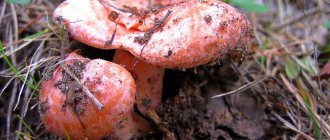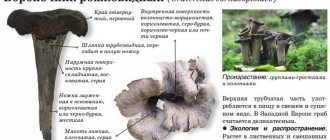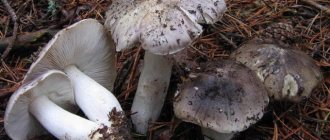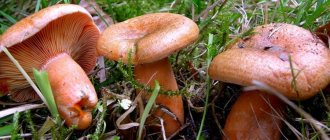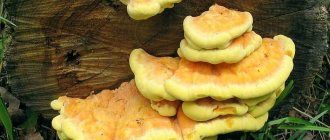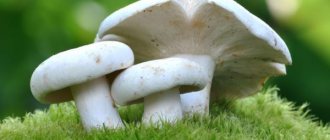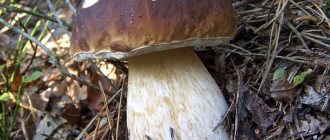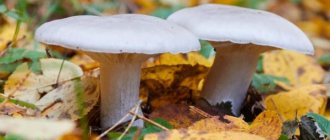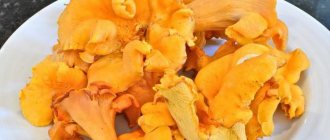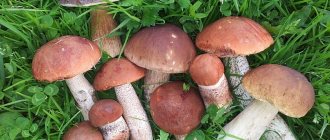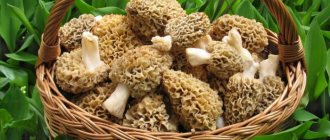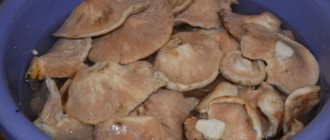Avid mushroom pickers know what their prey looks like. After all, initially they studied a lot of literature and looked at photos and descriptions of chanterelle mushrooms. However, what should those who are just starting to go on “silent hunting” do?
The first thing you need to do is study information about edible and false fruiting bodies, and also become familiar with the types of mushrooms in detail.
Appearance
The type representative of the genus is the common chanterelle. This is an edible mushroom in which the stem is fused with the cap. It has an orange tint, which can change to egg, yellow, etc. Sometimes the color fades to almost white.
Fox hats
The shape of the cap changes depending on maturity. At first it is slightly convex, then gradually takes on the shape of a funnel, most often irregular. The cap grows up to 10 cm, on average about 5 cm. The consistency is fleshy and smooth. The edges are wavy and uneven.
Interesting fact : chanterelles, as a rule, are not wormy, with rare exceptions.
The leg does not differ in color. It is dense, smooth, thin at the bottom and thickens towards the top. The average height is about 6 cm, thickness is no more than 3 cm. The flesh is also dense, yellow or orange. It is characterized by a slightly pungent taste and fruity smell.
Chanterelle hymenophore
The hymenophore is folded in the form of false plates. They are thick, not densely spaced, from the cap they go straight down to the stem and smoothly pass into it. The spores are yellow.
Characteristics of the common chanterelle
Common chanterelle
The common chanterelle is also called the real chanterelle or cockerel. It is the most common species in its genus. The mushroom is quite small: the diameter of the cap rarely exceeds 10 cm, the height of the stem is between 4–6 cm, and its thickness is 1–3 cm.
The chanterelle's cap smoothly transitions into the mushroom stem due to its funnel-shaped shape. The skin of the chanterelle is smooth to the touch and matte. It is difficult to separate from the dense pulp. The lower surface of the cap is covered with folds that run down the stem. The common chanterelle exudes a pleasant fruity aroma.
Also, real chanterelle is distinguished by the fact that the pulp does not contain worms and insect larvae. After ripening, the mushroom does not rot, but simply dries out. This is due to the peculiarities of the chemical composition of chanterelles.
Due to its color, the chanterelle is often the prey of a “silent hunt”, as it is easy to spot and grows in large groups. Most often, chanterelle grows in areas with high humidity, in mixed and coniferous forests, especially in well-lit areas in fallen leaves, moss or dried grass.
Chanterelles begin to be collected in mid-July and end in October. Chanterelles grow in large numbers after heavy rains. It is better to collect chanterelles that are pale yellow in color, since overripe mushrooms have a bright orange color and should be avoided.
When growing, collection period
Chanterelles are considered typical representatives of summer mushrooms. The first ones appear at the end of May. They bear fruit all summer until autumn. If the weather remains warm, chanterelles can be found until the end of October.
At the beginning of summer there may still be very few of them, so the optimal time to go mushroom picking is no earlier than mid-June. The period of most active growth of chanterelles is early July and September. The best harvest can be expected after rains and fogs.
Interesting: The most popular conditionally edible mushrooms: list, names, photos and videos
Places of growth
The chanterelle mushroom is edible and has about 60 varieties. Their peculiarity is a bright, rich color and a cap that is almost completely fused with the stem. The main habitats are mixed and coniferous forests of the temperate zone. Chanterelles are found both in Kuban and Siberia.
As a rule, they grow in large groups, so you can easily collect so many of them that there will be enough for a whole year of pickles, marinades or roasts.
Reference! These mushrooms are found almost all over the planet - in Europe, Asia, America and Africa. They are loved by gourmets all over the world.
Time and place of collecting chanterelles
Mushrooms bear fruit in two periods - in June and from August to October. Sometimes in a very warm spring they can appear in May. You need to look under pines and fir trees, oaks or beeches. It is with these tree species that the mycelium of chanterelles forms the best symbiosis. Such mushrooms do not like dark places; you need to look for them along the edges and clearings.
If you are lucky enough to come across a bright red cap, you should take a close look at the forest floor - chanterelles never grow alone. They form large families, so that several buckets can be carried from one clearing.
Where do they grow?
Chanterelles have varied preferences for certain tree species. You should look for them under spruce, oak, pine, and beech trees. They can grow in any forest. Often found among birch groves.
Chanterelles grow on a pine forest floor
Mushrooms love high humidity, so they often grow on coniferous or deciduous litter, among mosses. May be found nearby with rotten trees. They usually grow in groups, so if you find one mushroom, there are probably others nearby.
Interesting fact : chanterelles are not afraid of bad weather, unlike other mushrooms. So, during drought they simply stop growing, do not dry out, and during heavy rains they do not rot.
The use of chanterelles in cooking and medicine
Chanterelles are suitable not only for preparing various dishes based on them, but also for making medicines.
Chanterelles in different dishes
Chanterelles have high taste qualities, so they are included in various dishes.
Before cooking, the mushrooms are processed: thoroughly washed and then dried. After this, the roots of the chanterelles are cut off and the soil is scraped off, and the broken edges of the cap are cut off.
You can store chanterelles in the refrigerator for no longer than 2 days, as they spoil quickly. Under no circumstances should they be placed in plastic bags, as the mushrooms will suffocate in them and become moldy.
The following delicious dishes are prepared from these mushrooms:
- mushroom soup;
- vegetables baked in the oven with chanterelles;
- pie with cheese and mushroom filling;
- pilaf with chanterelles;
- fried potatoes with mushrooms;
- spaghetti with mushrooms;
- creamy sauces with pieces of chanterelles;
- buckwheat porridge with fried chanterelles;
- omelette with mushrooms.
Chanterelles can also be pickled for the winter and frozen. It should be remembered that freshly frozen mushrooms are stored in the freezer for no longer than six months. Dried mushrooms in powder form can be stored for a year.
The use of chanterelles in the manufacture of medicines
Due to their medicinal properties, chanterelles are also used to prepare remedies for various diseases.
Most often, the following medicinal compositions are prepared based on these mushrooms:
- Tincture against helminths. To cleanse the body of parasites, you need to prepare the following remedy: dry the chanterelles and grind them into powder, take three tablespoons of the resulting raw material and pour in 300 ml of vodka. The container should sit for 3 weeks in a cool, dark place. It is necessary to shake the bottle periodically. You need to take 20 ml of tincture in the evening. The duration of treatment is 14 days.
- A means to improve vision. To prepare, take 10 g of dry chanterelle powder and two glasses of water. Pour boiling water over the powder and place in a water bath. Boil for a quarter of an hour, remove from heat and leave for an hour. There is no need to strain the finished broth. Take it cooled three times a day before meals, a dessert spoon. During one course of treatment you need to drink about 3 liters of mushroom broth.
- Decoction for cleansing the liver. To prepare, take a tablespoon of fresh chopped mushrooms. Mushrooms need to be poured with boiling water (one and a half cups). Put it all on the fire and cook over low heat for 20 minutes. Next, remove the mixture from the heat and leave for 4 hours. Strain before use. Take a tablespoon 4-5 times a day, 40 minutes before or an hour after meals.
- Chanterelles are recommended for consumption by those who want to lose excess weight. To do this, you should introduce dried mushroom powder into your diet. You need to take it one teaspoon twice a day with water.
Before using chanterelles for therapeutic purposes, you should consult your doctor to make sure there are no contraindications.
Chanterelle mushrooms grow in forests. They can also be grown on your own plot of land in a home farm, but only extensively: such mushrooms do not grow in greenhouses. Based on chanterelles, you can prepare various dishes and medicinal compositions for various diseases.
0
0
Copy link
How long does it take to grow?
The ripening time of mushrooms depends on weather conditions. After heavy rains, you can go looking for chanterelles within a couple of days. In general, they need about a week to reach the required size. It is recommended to avoid overripe specimens, as they accumulate harmful substances and toxins.
Chanterelles can deteriorate and rot, like any other mushrooms. However, they are characterized by one feature - neat rotting. Damaged mushroom pulp stands out noticeably and can be easily removed.
Edible and inedible chanterelle: what is the difference?
Unlike edible mushrooms, harmful mushrooms often grow not as a family, but alone. They prefer old fallen trees or rotting stumps. By the shape and color of the caps, without even holding them in your hand, you can distinguish an edible chanterelle from a false one (people call them talkers).
False chanterelle
A real mushroom has a rich, but not flashy color. False - a bright, saturated, fiery color with an admixture of brown. The color of the chanterelle's cap is uniform, while the edges of the "talker" are lighter than the middle.
Edible mushrooms have an uneven, wavy edge. While the cap of the false ones tends to have an ideally even side, slightly rounded down. The flesh of the “talker” is yellow and does not change color when pressed. The smell is unpleasant, pungent.
The most striking distinguishing feature is the thin leg. In the chanterelle it is dense, smooth, yellow in color, expanding upward and connected to the cap. The inedible double has a leg of the same diameter along its entire length, reddish in color and clearly separated from the cap.
Reference!! Chanterelles, like other mushrooms, cannot be collected near cities, roads or industrial enterprises.
Types of chanterelles, names and photos
In addition to the common chanterelle, the following species are known:
- gray;
- tube-shaped;
- black;
- pale (white);
- yellowing;
- amethyst;
- velvety;
- faceted;
- cinnabar red;
- club-shaped.
Gray fox
The gray chanterelle or funnel funnel is considered a conditionally edible mushroom that has almost no taste. The cap is curved, funnel-shaped, and has a gray-brown tint. The folds on the inside are usually lighter. The leg is small, thin, ashy in color. The mushroom usually grows in groups.
Gray fox
Tube-shaped fox
The tube-shaped chanterelle is edible and small. The cap is about 3-4 cm, the leg is no more than 6 cm. The color is brown and dull. The leg is slightly lighter, smoothly transitions to the upper part. The edges are torn and significantly concave inward. The color is not uniform.
Tube-shaped fox
False plates of a light shade. The smell is mushroom, pleasant. The tube-shaped chanterelle grows from August to the end of October. Found near coniferous trees.
Black fox
Black chanterelle is conditionally edible, dark gray in color. The hat and the leg are one whole. The surface is dry and uneven. The hat is darker, funnel-shaped. The edges are light and curved upward. There are no false plates on the back of the cap.
Interesting: Why are chanterelle mushrooms called that?
Black fox
The leg is hollow, up to 10 cm in height. The pulp of the mushroom is very fragile and thin. There is practically no smell. After heat treatment it becomes black. Grows from July to the end of September. Only the caps are eaten.
Pale (white, light) fox
The pale (white, light) fox is very similar to the common one. The main difference is the light, uneven shade, which can be white, cream, or pale yellow. False plates of the same color. The mushroom grows in June-September.
White fox
Yellowing fox
The edible yellowing chanterelle grows primarily near coniferous trees. The caps are small (up to 5 cm), funnel-shaped with a large depression. The edges are sinuous, concave inward. The shade is brown with a yellow tint.
Chanterelle yellowing
The leg is tall, thin, narrow at the base, yellow-orange. The hymenophore is folded, light. The pulp is fragile but dense. The nutritional value is low.
Amethyst fox
The amethyst fox is a large representative of the genus. It is distinguished by a dense thick stem - up to 4 cm in thickness, as well as an asymmetrical cap with torn, curved edges. The size of the cap varies from 2 to 10 cm. Its shape can be convex, flat, with a funnel in the center, depending on age.
Amethyst fox
The color of the mushroom is yellow, dark or rich with various spots. The stem and hymenophore match the color of the cap. The chanterelle grows from June to October in forests of any type.
Velvety fox
The velvety chanterelle is a rare species that grows in the deciduous forests of southeastern Europe. The cap is about 4 cm, can be convex or funnel-shaped. Shade – red-orange or bright yellow. The edges are wavy. The leg is small, thin, yellow. The pulp may be orange, yellow, or white.
Velvety fox
Faceted chanterelle
The faceted chanterelle is an edible species. Usually grows near oak trees in groups. A characteristic feature of the species is an even more wavy, uneven cap, its edges hanging down. The dimensions of the fruiting body are from 2 to 10 cm. The color is bright yellow or orange. The folds are sparsely spaced or absent. Fruits all summer and until autumn.
Faceted chanterelle
Cinnabar-red fox
The vibrant cinnabar red chanterelle stands out in its rich red-orange color. These mushrooms are small: the cap is no more than 4 cm, the stem is also up to 4 cm in height. The shape of the cap is convex at first, then becomes flat or slightly concave. The pseudoplates are thick, the same color as the fruiting body. Chanterelle grows near oak trees in summer and autumn.
Interesting: Interesting facts about mushrooms, photos and videos
Cinnabar-red fox
Club-shaped fox
The club-shaped chanterelle has good taste. Quite a large mushroom: height up to 16 cm, thickness up to 10 cm. It grows in groups, and several fruiting bodies can grow together. The hat and leg are connected.
Club-shaped fox
Young mushrooms have a purple cap, which gradually changes to yellow. The leg is yellow-brown, covered with folds, and sometimes hollow. The mushroom grows from early summer to late autumn. It has white aromatic pulp and a pleasant taste.
General characteristics of mushrooms
Chanterelles are edible mushrooms. Representatives of the chanterelle family number 60 species, most of which can be eaten and also used for therapeutic purposes.
The peculiarity of the appearance of chanterelles is the absence of a pronounced cap. The latter is almost completely fused with the leg. Outwardly, they resemble an umbrella turned outward.
The color of the chanterelle's mushroom body ranges from light yellow to pronounced orange. The cap is smooth, with wavy edges, depressed in the middle. Its diameter can reach 12 cm. The stem of the mushroom tapers downwards. The mushroom has a slightly sour aroma.
Chanterelle bears fruit en masse, usually growing in whole groups. It is found in the period from June to October in all forest zones of Russia. It grows in especially large quantities after heavy rains.
The bright color of the mushrooms makes them quite easy to find. In addition, edible species of chanterelles usually grow in large families, so when going into the forest after rain, you can count on a large harvest of these mushrooms.
The most common variety of this mushroom is the common chanterelle. The most common types of chanterelles are true, common and tubular.
Chanterelles include:
- amino acids;
- chitinmannose;
- vitamins A, B1, B2, C, E;
- zinc;
- calcium;
- potassium;
- chromium;
- iron;
- cobalt;
- trametonolinic acid.
The chanterelle also has a double - a conditionally edible mushroom, which is still not recommended to eat. To distinguish a real chanterelle from a false one, you need to pay attention to the following features:
- edible species always grow in whole groups;
- when pressing on the flesh, the chanterelle changes its color, and the false chanterelle retains the same color;
- Edible mushrooms have a thicker stem;
- Inedible chanterelles have an unpleasant, repulsive odor and bad taste.
Edible chanterelles are suitable not only for preparing dishes from them: with the help of such mushrooms various diseases are treated.
Inedible and poisonous species
Orange talker
The orange talker has a small convex cap, which becomes flatter with age. The surface is dry, velvety. Various shades of orange are possible. The plates are of a brighter shade. When you press on them, brown spots appear.
Orange talker
The leg is low, up to 1 cm in diameter. The color is the same as the cap or more saturated. The pulp is dense, and in mature mushrooms it becomes cotton-like. White spore powder. The smell is weak, the taste is unpleasant, almost unnoticeable.
False chanterelles grow from August to the end of October. The growing conditions are the same as for the edible mushroom. For a long time, the talker was considered poisonous. Now it is classified as a mildly poisonous or conditionally edible mushroom - there is no consensus. Experts advise refraining from eating it.
Red false fox
The red false fox has only recently become an independent species. The cap of this mushroom grows up to 10 cm. Possible shades: yellow, orange, brownish. It is worth noting a darker spot in the center of the cap, as well as noticeable small scales.
Red false fox
Scales are also visible on the leg. Its color matches the color of the cap. The pulp is orange in color and does not change color when damaged. The smell and taste are weak. The mushroom is considered conditionally edible, but its nutritional properties are very low.
Omphalotus oleifera
Omphalotus oleifera is an inedible poisonous mushroom. Inexperienced mushroom pickers may confuse it with chanterelle, which can lead to poisoning. The hat changes shape depending on age. First convex, then flat or funnel-shaped. The edges are strongly curved inward. Color ranges from pale yellow to orange-brown.
Interesting: Edible mushrooms - list, photo, name, description, video, when and where they grow
Omphalotus oleifera
Interesting fact : Omphalotus oleifera plates can emit a faint glow at night.
The leg is uneven and dense. It may be the same color as the cap or a little lighter. The pulp is fibrous, yellow. The smell of the mushroom is unpleasant, and there is almost no taste. Omphalotuses grow near deciduous trees, on olive stumps. The growth period is all summer and autumn.
Yellow hedgehog
Separately, it is worth noting the yellow hedgehog . This mushroom is similar in appearance to a chanterelle, but even if there is confusion, nothing bad will happen. The blackberry is absolutely edible with excellent nutritional qualities. Unlike chanterelles, under the cap there are not plates, but small spike-like growths that easily break off. The taste is identical to chanterelles.
Yellow hedgehog
General distinctive features of the edible chanterelle from its counterparts:
- Color . Chanterelles usually have an even shade without spots, streaks, etc.
- Smell . The fruity aroma of edible chanterelle is unlike its counterparts, which have almost no smell or emit an unpleasant odor.
- Hat . The edges are always uneven and curved.
- Leg . Always dense in the edible species and hollow or loose in some lookalikes.
- Worminess . Very rarely, chanterelles attract insects, while false species are not endowed with this property.
False chanterelles
Also check out these articles
- Grape variety Baikonur
- Radishes on the windowsill
- The best varieties of blackcurrant
- Potato variety Breeze
You can also find false chanterelles in the forest.
It is better to leave them, because they are dangerous to human health and can cause food poisoning.
It is important to know what color the chanterelles are and what they look like.
To begin with, it would be a good idea to look at the drawing in the training book, so that later in the forest you can compare it and not make a mistake.
Orange talker (inedible)
- Diameter – 8 cm. Characterized by a funnel-shaped shape and a yellow-orange hue.
- The surface of the cap is felt, the lower part is covered with thin gills.
- Leg height – up to 5 cm.
Omphalote olive (poisonous)
Externally, this variety closely resembles ordinary fruiting bodies. The height of the fruiting body is up to 15 cm. The diameter of the apex is about 5 cm.
In its lower part there are sharp gills that do not bifurcate. The inside of the leg has an orange tint.
Yellow hedgehog
This variety also resembles the classic edible subspecies. This false mushroom can be distinguished only by the small spines that are on the cap.
It can be eaten, but only after careful heat treatment. But it’s better to play it safe and not eat this mushroom.
Why do chanterelles taste bitter?
The bitter taste in chanterelles occurs due to violations of the technology for preparing and storing mushrooms, as well as in case of errors during their collection.
It is recommended to collect chanterelles at a young age, when they have not yet acquired a rich orange color. You should avoid going for mushrooms during the dry season, and also avoid chanterelles growing along highways and near industrial facilities. Such mushrooms accumulate many toxins and harmful substances.
Quite often, bitterness appears in chanterelles growing in coniferous forests
All of the above conditions for mushroom growth can cause their bitterness. Separately, false chanterelles can be noted. Once a couple of these lookalikes get into a dish with edible mushrooms, the taste will be ruined.
Improper processing of mushrooms can also cause a bitter taste. For example, before freezing, chanterelles need to be cleaned, cut out all damaged areas, washed, soaked in salt water for several hours and boiled for about 8 minutes. It is important to harvest mushrooms as soon as possible after harvesting.
Beneficial and harmful properties of chanterelles
These mushrooms are characterized by a rich composition, which determines their valuable properties. Chanterelles have the following actions:
- cleanse the liver of parasites and normalize its function;
- help improve a person’s condition in the presence of hepatitis;
- effectively fight infections with bronchitis, sore throat, furunculosis;
- promote weight loss;
- eliminate irritability;
- improve vision;
- reduce blood cholesterol levels;
- improve the activity of the thyroid gland;
- increase immunity;
- normalize blood pressure;
- suppress the growth of cancer cells;
- strengthen blood vessels;
- influence the formation of elastin and collagen;
- regulate the concentration of glucose in the blood;
- promote the breakdown and digestion of food;
- protect the body from stress;
- remove toxins from the body;
- normalize heart rate;
- improve joint mobility.
For medicinal purposes, chanterelles are consumed in powder form or fresh: boiled or fried mushrooms lose most of their valuable properties.
Despite the benefits of chanterelles, certain categories of people should not consume them. So, contraindications to their consumption are:
- periods of pregnancy and breastfeeding;
- individual intolerance to mushrooms;
- children's age up to 7 years.
Those who suffer from diseases of the gastrointestinal tract should treat mushrooms with special caution, since chanterelles are a difficult-to-digest product. If you have kidney disease, you should also limit your consumption of chanterelles and other types of mushrooms.
Despite the fact that most types of chanterelles are edible, they can still cause harm to health if they were collected near existing industrial enterprises or large highways. In such places they accumulate large amounts of heavy metals and other harmful substances.
Why are chanterelles not wormy?
Worminess in chanterelles is a very rare occurrence, thanks to a special substance contained in these mushrooms. We are talking about D-mannose or quinomannose, a natural monosaccharide.
Hinomannose repels various insects, parasites, and helminths. Moreover, the substance acts on both adult individuals and their larvae. As soon as an insect comes into contact with quinomannose, the monosaccharide begins to have a paralyzing effect on it.
Interesting fact : D-mannose is destroyed at temperatures of +50℃ and above, as well as upon contact with acids and salts.
Still there are some exceptions. For example, wireworm larvae and black beetle larvae are not afraid of quinomannose, so they can sometimes be found in chanterelles. Their bodies are covered with a denser shell compared to other worms, which serves as protection against the monosaccharide.
Interesting: The most useful mushrooms - list, names, descriptions, photos and videos
Yellowing Chanterelle Craterellus Lutescens
Chanterelle mushrooms – varied and tasty
Mushroom from the genus Voronochnik, Chanterelle family.
Appearance
The cap is dry and brittle, up to 5 cm in diameter, deeply funnel-shaped, with a rolled, uneven edge. Painted in brownish-yellow shades.
The hymenophore is folded, but in young fruiting bodies it is almost smooth - small folds appear with age. Colored in yellow shades, graying with age. Spore powder is light orange.
The leg is up to 10 cm long and up to 1 cm in diameter, yellowish in color. Tapered at the base and often slightly curved, it may have longitudinal folds. Hollow inside.
The pulp has a yellowish tint and a slightly rubbery consistency. It does not have a pronounced taste or smell.
Where and when does it grow
Grows in coniferous, usually spruce, forests in August and September. Fruits in small groups.
Culinary use
This species belongs to category 4 edible mushrooms, and it is recommended to boil it for 15 minutes before consumption, after which it can be prepared in the usual way.
Beneficial features
Chanterelles have high nutritional and energy value. The calorie content of the mushroom is 19 kcal/100 g. Also, 100 grams of chanterelles contain:
- proteins – 1.5 g;
- fat – 1.1 g;
- carbohydrates – 1.1 g.
Chanterelles are rich in amino acids, vitamins (C, A, E, B1, B2, D2), microelements (zinc, calcium, potassium, iron, chromium), as well as trametonolinic acid. They contain ergosterol, which has a beneficial effect on liver function, and K-10 polysaccharide. Quinomannose has an antibacterial effect.
Benefits of chanterelles for human health
Like any other forest mushrooms, chanterelles are a tasty and healthy food that contains:
- a large amount of vitamin D2, it helps the human body absorb calcium;
- significant amount of protein;
- vitamin A;
- potassium;
- iron;
- chromium;
- eight essential amino acids that are valuable for the human body.
This type of fungus is quite intolerant to elevated levels of nitrogen and is not found in areas with high levels of air pollution. It is a mycorrhizal species and is therefore always associated with trees that do not adversely affect human health, including oak, beech, pine and birch.
The fruiting bodies are relatively long-lived, partly because they resist fungal parasites and are rarely eaten by larvae. It's nice to know that the harvested crop is not affected by arthropods. This feature contributes to the popularity of chanterelles as an edible species!
Why are chanterelles called that? Other names
The Latin name for the common chanterelle is Cantharellus cibarius. This is how the mushroom was named by the Swedish mycologist Elias Magnus Fries in 1821. This name can be roughly translated as “edible bowl,” which is probably due to the funnel-shaped shape of the cap.
The Russian version of the name “chanterelle” is primarily associated with the red fox, and it is no coincidence. The fact is that these words come from the Old Russian “fox” - that is, “yellow, red”.
The first to officially describe and name the chanterelle mushroom was the Swedish scientist Carl Linnaeus in 1753 - Agaricus cantharellus
Other names are also used by people: real chanterelle, cockerel and sploen. The last two options are associated with the uneven curved edges of the cap.
Most other countries use names for this mushroom that are derived from the Latin form. For example, in English, Norwegian, and French, a chanterelle is called chanterelle, and in Danish – kantarel.
Some languages have their own approach. The Germans call the mushroom “a real chanterelle (cheat)” - Echter Pfifferling. The second name is Eierschwammerl, which means egg mushroom. Translated from Chinese, 鸡油菌 means “yolk-colored mushroom.”
Funnel Fox Craterellus Tubaeformis
Chanterelle mushrooms – varied and tasty
A mushroom from the genus Funnelwort, Chanterelle family, also known as Tubular Chanterelle or Tubular Chanterelle.
Appearance
The cap is up to 6 cm in diameter, convex in young mushrooms, then becomes more and more elongated, acquiring a funnel-shaped shape. The edges of the cap are turned up, it has a yellowish-brown color, with lighter edges and a pattern of darker fibers in the central part.
The hymenophore is folded, the folds descend onto the leg in a branched network, and are colored in light gray shades. The spore powder is grayish or yellowish.
The stem is up to 6 cm high and up to 0.6 cm in diameter, bare, cylindrical and hollow, smoothly turning into a cap. Painted in yellowish or light brown tones.
The pulp is thin, elastic, with a pleasant mushroom smell and taste.
Where and when does it grow
This mushroom loves damp, mossy coniferous and mixed forests and acidic soils. Fruits in large groups from late August to late October.
Culinary use
This mushroom is inferior to the Real Chanterelle in its taste, but is also quite good and suitable for any type of culinary processing.
In a number of Northern European countries, the mushroom is considered almost a delicacy.
Experts advise that when cooking, first dry it in the fresh air, in a shaded, ventilated place, for 24 hours, and then fry it in butter.
Preparation and storage
Mushrooms are easily cleaned of dirt with a soft brush - there is no need to peel off the skin from them, as with other types. Storage in a cool place (up to +10℃) is possible for two days, no more.
Interesting: Why are mushrooms not plants?
Dried chanterelles
Chanterelles are versatile in terms of cooking. They can be boiled, fried, dried, pickled and salted, and also frozen. They cannot be re-frozen.
How to prepare and preserve chanterelles for medicinal purposes
But before you use chanterelles for treatment, you need to properly collect them and subject them to the necessary processing.
It is necessary to remove dirt and debris from the collected mushrooms with a dry brush. The more carefully you do this, the longer their shelf life will be. There is no need to wet fresh chanterelles. After this, you can store the chanterelles in the refrigerator for no more than 10 days.
Next you need to choose in what form to use the mushrooms - salted, dried or frozen. Freezing chanterelles will ensure the preservation of all beneficial properties.
The flesh of dried chanterelles can become rubbery, so they are usually ground into a powder that has a shelf life of about a year. In this case, the temperature when drying mushrooms should not exceed 40°C.
Accordingly, for medicinal purposes, chanterelles are eaten fresh or in powder form. The powder is added to prepared dishes. Boiled and fried mushrooms will have much less nutrients.
Growing chanterelles at home
It is possible to grow chanterelles on a personal plot, but it requires creating conditions close to natural ones. To grow mushrooms at home or in the country, you need to acquire mycelium or planting material (caps). It is worth noting that the first option is more reliable, and the second, if successful, will produce a harvest faster.
Chanterelle mycelium is sold in specialized stores. You can also collect it yourself in places where mushrooms constantly grow. This is done by digging out the top layer of soil (about 15 cm deep). It is important to collect and transport the soil carefully, since the mushroom threads are very thin.
Mycelium (mycelium)
The mycelium is kept in small separate containers for a year at low temperatures. This will help him become more resilient. If the planting material was purchased at the store, you can immediately begin planting.
The optimal time is June. Chanterelle mycelium is planted next to the most suitable trees for these mushrooms. It is poured into a hole about 20 cm deep, compacted, and watered abundantly. For wintering, planted areas are insulated with coniferous litter, dry leaves, branches, etc.
Interesting fact : chanterelles are not grown in greenhouses. The presence of natural conditions is mandatory for them.
To grow chanterelle caps, they are soaked in slightly sweet water for 15 hours. A liter of water requires 100 g of sugar. Then the caps are thoroughly crushed, and the resulting liquid mixture is filtered, but there is no need to throw anything away.
It is important to choose a place for planting next to the same tree near which the mushrooms were collected. The top layer of soil is removed, and the soil is watered with a decoction of oak bark. This is necessary to combat microorganisms.
After a couple of hours, the liquid with fungal spores is poured onto the selected area, and the pulp is spread on the bare areas of the tree roots. Then the planting site is covered with earth and watered moderately. In winter it is also covered with branches or hay. The first harvest can be expected in a year.
First aid for mushroom poisoning
1.5 hours after eating inedible mushrooms, the first symptoms of poisoning appear. Vomiting and nausea, diarrhea with pain, and indigestion appear. The pulse becomes weaker, the extremities become cold, but the body temperature rises. The gastrointestinal tract becomes inflamed, hallucinations and delusions appear. Sometimes, in a difficult situation, insanity sets in in the mind.
If at least one of the listed symptoms appears after eating, you must call an ambulance. What can you do before she arrives?
- Put the victim to bed.
- Give plenty to drink, water or iced tea.
- Give activated carbon (1 tablet per 10 kg of weight).
Watch the video! Chanterelles fried in sour cream
You should be careful not to pick mushrooms that cannot be eaten.
Now, armed with knowledge of what chanterelle mushrooms look like , you can safely go hunting.
What are the benefits of chanterelles?
- They contain many vitamins;
- Almost no worms;
- The ergosterol content in red mushrooms helps strengthen organs;
- Useful for curing diseases.
Chanterelles - medicinal properties
Chanterelles contain fluoride compounds
, strengthening the immune system.
In addition, this mushroom contains the substance quinomannose
, which has a detrimental effect on some types of worms.
Thanks to this substance, the development of parasites, bugs and worms is stopped, the substance destroys the capsules of their eggs.
Therefore, you will never find chanterelles damaged by worms, which cannot be said about other mushrooms.
Quinomannose
- a natural substance that absolutely cannot withstand heat treatment, collapsing at temperatures above 50 degrees. It is completely absent in boiled and fried mushrooms.
Chanterelle mushroom contains ergosterol
– used to cleanse the liver. Scientists have found that chanterelles contain trametonolinic acid, which can effectively fight the hepatitis virus.
In folk medicine, chanterelle mushrooms are actively used both for the prevention and treatment of various diseases.
To prevent the decay of many healing substances in chanterelles, they are not subjected to heat treatment.
The only way is drying
at a temperature not higher than 45 degrees or
alcohol tincture
(no more than 38%).
Medicinal tincture
It’s very simple to do: to do this, take 1 tablespoon of dried and chopped chanterelles and pour a glass (200 ml) of vodka. Leave to infuse in a dark place for 10 days.
You should take 1-2 teaspoons of the medicinal tincture before bedtime.
To combat parasites
take 2 tsp. tinctures for 20 days.
In the treatment of the pancreas and liver
– take 1 tsp. tinctures every evening.
If you decide to just cleanse your liver
– take 2 tsp.
Chanterelle tinctures for 15 days. Chanterelles are tasty mushrooms that remove radionuclides
.
Return to contents
Video – Healing chanterelles
Where and how they grow, in what forests and how to collect
Chanterelles are common in Europe, Asia, America, and in all types of forests. But these organisms feel best in the company of oaks, spruce, pine and birch trees. In Russian forests this is one of the most common mushrooms.
Experienced mushroom pickers advise anyone who wants to collect a lot of chanterelles to carefully examine areas of the ground covered with moss or fallen leaves. It is in such places that young mushrooms most often hide. The fruiting period is from June to early October.
You should go on a quiet hunt with a sharp knife in order to carefully cut off the fruiting body without damaging the mycelium. It is strictly forbidden to collect mushrooms near roads or industrial facilities. Their fruiting bodies easily absorb carcinogenic substances and heavy metals. Such a mushroom, even if it was originally edible, turns into a product dangerous to human health.
How to cook and store chanterelles?
Chanterelles are boiled, fried, salted, pickled, dried
.
Boil chanterelles
within 15-20 minutes after boiling. If you eat chanterelles after cooking, add salt to the water. If you fry after cooking, you do not need to add salt and the cooking process in this case will not last longer than 5 minutes.
Wash the dried chanterelles and soak them in warm water for 2-4 hours before cooking. Then cook in the same water for 40 minutes.
Chanterelles are fried
without boiling, but if the chanterelles are bitter, then you need to boil them.
Slice the mushrooms before frying. First, fry finely chopped onion in oil in a frying pan, then add the chanterelles. Fry the mushrooms until all the moisture has evaporated. Then add salt to taste, add sour cream and simmer until tender for 15 minutes.
Chanterelles are salted cold and hot.
Marinated chanterelles are prepared with and without pasteurization.
Marinated chanterelles with pasteurization
Thoroughly clean and wash the mushrooms, chop large ones and cook for 15 minutes in salted water with the addition of citric acid.
Place the prepared chanterelles in clean jars and pour the hot marinade over them, adding onion rings and bay leaves on top. Cover the jars with lids and pasteurize for 2 minutes. Then immediately roll up the lids and store in a dry place with a temperature of 0 to 15 degrees.
Drying chanterelles
on a drying board or a special dryer, the mushrooms should not touch each other. Before drying, mushrooms are not washed, but they are cleaned of dirt with a brush if large ones are cut into several pieces.
The rooms in which chanterelles are dried should be well ventilated. Can be dried outside in the shade.
If drying in a stove or oven, first the temperature should be 60-65 degrees, and then higher.
Store dried chanterelles in glass or plastic containers with tight-fitting lids.
Return to contents
Edibility
There are both edible and inedible types of chanterelles. The common chanterelle has a pleasant smell and a delicate hue, and the false mushroom smells like fish or vinegar.
The main differences between edible chanterelles and inedible ones are:
- Hat color. Inedible chanterelles are bright orange, while edible ones are yellow.
- Hat shape. Inedible mushrooms have a clear circle shape.
- Leg. A real mushroom has a thick stalk, while an inedible mushroom has a thin stalk.
- Smell. Inedible representatives of chanterelles have a vinegary odor.
- Habitat. Inedible chanterelles grow on fallen trees in deciduous forests, while real ones grow in mixed or coniferous forests.
- Pulp. Edible chanterelles have yellow flesh with white flesh in the center. Fake mushrooms have orange flesh.
If the mushrooms are real, then they can be fried, boiled or baked. Chanterelles make good casseroles, pies, zrazy and soups. All these dishes will not take more than an hour of preparation. Chanterelles can also be salted, pickled or dried, but this will take more time.
How to freeze chanterelles for the winter?
Clean the mushrooms from dirt, rinse and dry on a towel. You can freeze fresh, boiled, fried chanterelles.
When eaten raw after freezing, mushrooms may taste bitter.
Place the prepared mushrooms in bags or food containers and close tightly. Store in the freezer for 1 year at a temperature of -18 degrees.
You need to defrost the chanterelles in the refrigerator on the bottom shelf, at a temperature of +4 degrees. Thawed mushrooms cannot be re-frozen.
Return to contents
